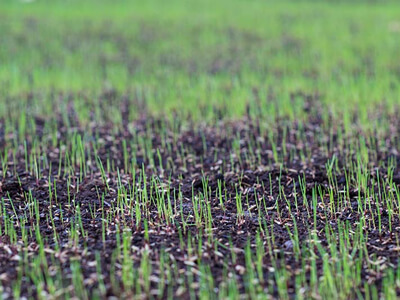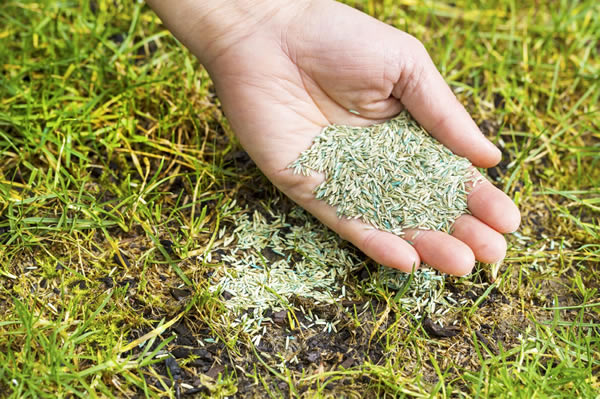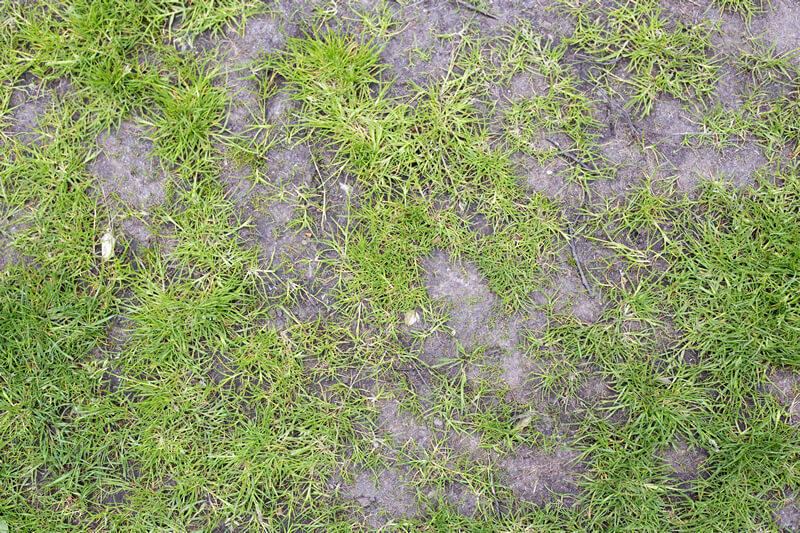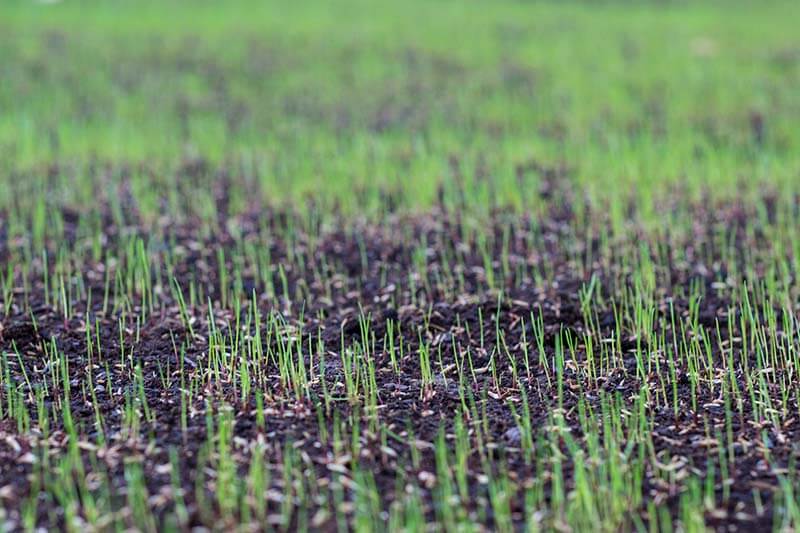Why over-seed my lawn?
- Lawns sometime become thin over time, over-seeding your lawn fills these gaps
- Seed breeders are continually developing new varieties of grass plants better suited to current growing conditions
- Damaged lawns can be repaired economically by over-seeding
- Regular over-seeding is a great way to keep a lawn in tip-top condition
- Lawns can wear out over time. It’s good practice to help your lawn stay in the best condition by regularly over-seeding – little and often.

If it dries it dies – keep new seed moist
What grass varieties are best for my lawn?
What grass grows well in shade?
Is seeding a lawn better than turfing it?
When is the best time to overseed?
If so, read on…
Lawn seeding briefly explained…
- Seeding an existing lawn is the perfect process to introduce new grass types
- Different grass varieties are better suited to different growing conditions
- Over-seeding is a great way to deal with bare patches or thin lawns
- If your lawn is starting to look worn out then over-seeding is a great way to fix that
We select the exact seed mix for your lawn situation

Why is my lawn bare?
The lawn is not really a natural environment for grass plants. In nature, grasses put up a seed head and this seed is distributed by the wind, where it falls on bare earth, germinates and creates a new grass plant. In our lawns we don’t allow this to happen as we mow them regularly which prevents grasses from seeding and filling in the bare areas.
Do all grasses rely on seeds to create new plants?
No, some grasses reproduce by sending out creeping runners which can root and create young grass plants. These grass types are great at filling in bare gaps on lawns, but can also contribute to problems such as surface lawn thatch.
What causes the grass to die?
Nothing lives for ever and your lawn grass plants are no different. Over time older grasses may die back leaving your lawn looking bare and unsightly. In addition, grass can be killed by disease, fungal attacks or even by dog urine burns. Compaction issues make it harder for grass to be healthy and can result in bare areas that need attention. Poor winter weather, low temperatures combined with excess rain and waterlogging will often cause dead grass. Leaves, grass clippings and other autumn debris, left on the lawn for excessive periods, can cause established lawns to suffer grass death. Lawn pests such as Chafer Grubs or Leather Jackets will kill grass plants too, resulting in a lawn needing repair work and seeding.
Why are bare areas in my lawn a problem?
A lawn with bare areas looks unsightly. Bare soil can become muddy. It’s unpleasant to sit on, walk on or for children to play on. What we aim for with our lawns is a dense area of lush green grass. That’s why these bare areas need to be dealt with before they become more of a problem.
Bare lawns, moss, and weeds
Bare soil in your lawn is the ideal place for weed seeds or moss to settle and colonise your lawn. Warm autumn soil is the ideal place for weed seedlings to germinate and develop. Quickly establishing themselves and often dominating smaller grass plants. Weeds and moss in your lawn is undesirable and over time they may begin to outcompete your lawn grass for nutrients, moisture and light resulting in weaker grass and an unsightly lawn.
Why are new seed mixes better than my existing turf?
The seed companies employ specialist seed scientists who develop new types of plants, better suited to certain conditions. As our climate changes we are finding that some grass plants are suffering more with Red Thread disease and Fusarium Patch. Modern seed blends are better suited to current climate conditions. Root depth, greener leaves, more disease and drought tolerance are high on the agenda of seed companies. By sowing a layer of a seed mix of the right grass types, evenly over your whole lawn, new grass varieties can be introduced into your lawn. These grasses may be better suited to how you want to use your garden and any particular cultural issues your garden environment presents.
How often should I seed my lawn?
The frequency that a lawn needs over-seeding will depend on a number of factors. If the lawn tends to get waterlogged, has problems with dog urine burning the lawn and killing your grass, or your garden is rather shaded, then repair work will be required more often to keep the lawn looking at its best. Some lawns perform better than others and need seeding less often. This is often dependant on what grass varieties are currently present in the lawn. Annual lawn aeration in the autumn, followed by a light over-seeding, is good practice for the best lawns.
Is it OK to just seed small areas of the lawn?
This can be ok if you are certain that you are using the right seed blend to match the existing grasses in your lawn. If not, then you could well end up with a lawn that looks patchy and has areas of different grass types with different shades of green and different size of leaf blade. This can be very unsightly and is best avoided. It’s far better to overseed your lawn entirely.
How to overseed a lawn
- Smaller areas can be prepared with a spring-tine rake
- Larger areas should be aerated first or scarified to create a good seedbed
- Apply the right mix of seed evenly with a spreader to ensure the correct coverage
- Use the right amount of seed. Neither too little or too much
- Seed contact with the soil is essential – preparation of the area is key to successful germination
- After seeding smaller areas use a brush to work the seed into the soil
- Larger areas can be worked over with a drag-mat to increase seed to soil contact
- Water your lawn regularly to start germination. Don’t rely on the weather
- Once seed begins to germinate it is essential not to let it dry out – if it dries, it dies!
- Ensure your lawn has the right fertiliser to encourage rapid development of the young grass plant
- Mow regularly to encourage the new grass plants to make side shoots and fill gaps
What are the different types of grass for my lawn?
-
Dwarf rye grass
-
a relatively new arrival in the world of lawncare. This grass is quick to germinate, has darker green leaves and is hard wearing. However, it won’t put out runners and it won’t fill in gaps. It doesn’t tolerate short mowing and likes plenty of nutrition
-
-
Bents
-
a finer leaf grass that can be mowed quite short. It will send out lots of runners and is great at filling spaces in a gappy lawn, but can become a bit of a thug, taking over the lawn and resulting in problem surface thatch. It tolerates drought and shade but is more susceptible to diseases.
-
-
Fescues
-
very fine leaves that grow in a tuft on top of a stem. They can become very springy and benefit from a regular short cut to prune them. Coping well in drought, but susceptible to Red Thread disease. A regular contributor to thatch problems, they require regular scarification or verti-cutting to manage this variety of common lawn grass. Aeration is also important with fescue lawns which will reduce issues with thatch
-

Patch seeding will fill in bare lawn areas

If it dries it dies – keep new seed moist

 Established 2016
Established 2016




